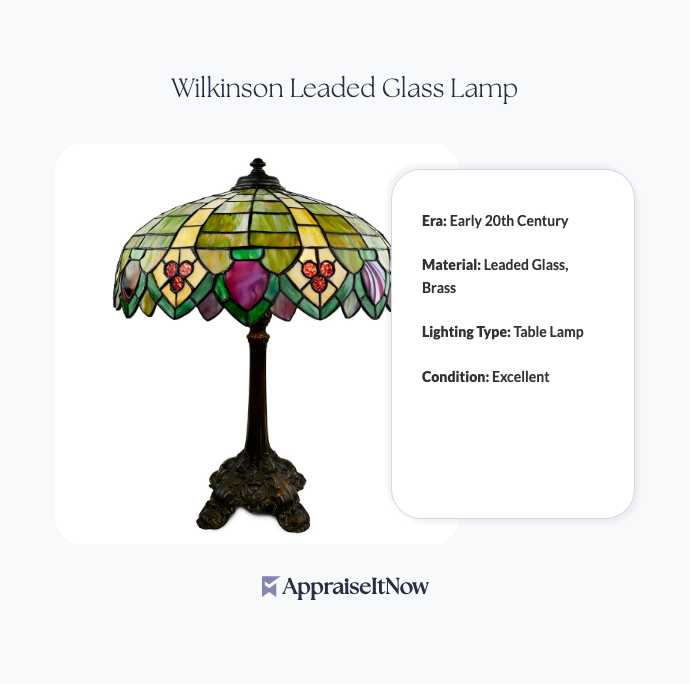<h1>How to Get Your Bradley Hubbard Lamp Appraised</h1>
<p>The Bradley Hubbard Lamp stands as a treasured piece of early 20th-century craftsmanship, commanding values between <strong>$7,500 and $9,000</strong> in today's antique market. If you own one of these sought-after fixtures, understanding how to properly identify, evaluate, and appraise your lamp ensures you capture its true monetary and historical value.</p>
<h2>Understanding Your Bradley Hubbard Lamp's Significance</h2>
<p>Bradley & Hubbard Manufacturing Company, founded in the late 1800s, became renowned for their innovative lighting designs and exceptional craftsmanship. Your lamp likely dates to the <strong>early 1900s</strong>, a period when the company introduced their revolutionary slag glass technique—a process that layered different types of glass to create uniquely textured, iridescent finishes. Each lamp produced using this method became an individual work of art, making them highly desirable among collectors and interior designers today.</p>
<p>The slag glass construction you see in your Bradley Hubbard lamp isn't accidental; it's the result of deliberate artisanal expertise. This technique creates colorful patterns and a distinctive frosted appearance that distinguishes Bradley Hubbard pieces from mass-produced lighting alternatives. The combination of decorative brass hardware and elegant silhouette reinforces why these lamps occupy a premium position in the <a href="/types/antique-furniture">antique furniture</a> and <a href="/types/household-goods">household goods</a> collecting world.</p>
<div class="callout tip"><p><strong>Collector's Insight</strong></p>
<p>Limited production quantities from 1910 onwards mean authentic Bradley Hubbard lamps with documented provenance often command premium prices exceeding base market estimates.</p></div>
<h2>How to Identify an Authentic Bradley Hubbard Lamp</h2>
<p>Distinguishing a genuine Bradley Hubbard from reproductions or similar period pieces requires attention to specific markers. When examining your lamp, look for the <strong>company name or trademark</strong> typically found on the base or socket—early examples may have impressed markings, while later versions often feature paper labels (though these frequently deteriorate over time).</p>
<p>The slag glass itself tells a compelling story about authenticity. Genuine Bradley Hubbard slag glass exhibits organic color variations and depth that modern replicas struggle to match. The glass layers create a natural dimensional quality, with colors often including amber, green, and cream tones blending together in irregular patterns. This handcrafted appearance contrasts sharply with uniform, machine-made glass surfaces.</p>
<p>Beyond the glass, examine your lamp's brass components carefully. Authentic Bradley Hubbard fixtures feature <strong>decorative brass hardware with specific patina characteristics</strong>—the wear patterns on original brass reveal genuine age and use. The base construction, typically cast metal with detailed design elements, should show consistent manufacturing techniques consistent with early 1900s production methods. Reproduction pieces often exhibit tooling marks or construction inconsistencies absent from original examples.</p>
<div class="callout note"><p><strong>Authentication Detail</strong></p>
<p>Matching socket styles, harp designs, and electrical components to documented Bradley Hubbard production records helps confirm authenticity and dating.</p></div>
<h2>Current Market Value and Pricing Factors</h2>
<p>The <strong>$7,500 to $9,000 valuation range</strong> reflects strong collector demand for quality Bradley Hubbard lamps in good condition. However, your specific lamp's worth depends on multiple factors beyond just age. Understanding these variables helps you comprehend what appraisers evaluate when assessing your fixture.</p>
<p><strong>Condition</strong> significantly impacts pricing. A lamp with original slag glass panels showing no cracks, original brass hardware without excessive pitting, and intact electrical components commands top-tier prices. Each significant restoration or replacement reduces value proportionally. Lamps requiring glass repair or hardware restoration typically fall toward the lower end of the valuation range, while museum-quality examples with pristine provenance documentation may exceed standard estimates.</p>
<p><strong>Size and shade configuration</strong> also matter considerably. Larger lamps with complex, multi-panel slag glass shades generally command higher prices than smaller accent pieces. The specific color combination of your slag glass—rare color palettes featuring unusual amber or blue tones often outperform standard green and cream combinations.</p>
<p>Documentation and provenance tell potential buyers your lamp's story. If you possess original purchase receipts, family history establishing continuous ownership, or any other historical documentation, these significantly enhance perceived value and ease of sale. This mirrors how professional appraisers evaluate <a href="/types/antique-artwork">antique artwork</a> and <a href="/types/memorabilia-and-collectibles">memorabilia and collectibles</a>—verifiable history increases confidence and desirability.</p>
<h2>When Did Bradley and Hubbard Go Out of Business?</h2>
<p>Understanding your lamp's production timeline provides valuable context. Bradley & Hubbard Manufacturing Company remained operational through the mid-20th century, though their golden era of innovation and market dominance occurred during the <strong>1900s through 1920s</strong>. The company eventually ceased lamp production as electric lighting technology advanced and consumer preferences shifted toward modern designs.</p>
<p>This relatively long production window means Bradley Hubbard lamps you encounter could originate anywhere within a 40+ year span, each era representing distinct design evolution. Early examples from 1900-1915 often showcase more elaborate slag glass patterns and brass ornamentation, while later pieces simplified designs to meet changing aesthetics. For your lamp specifically, an appraiser can narrow the production date using design elements, manufacturing techniques, and electrical components.</p>
<div class="callout tip"><p><strong>Historical Context</strong></p>
<p>Lamps produced during Bradley Hubbard's peak manufacturing years (1910-1920) typically command highest values due to superior craftsmanship and innovative designs.</p></div>
<h2>How to Tell if Your Stained Glass Lamp is Valuable</h2>
<p>Not all decorative glass lamps command premium prices, which is why distinguishing your Bradley Hubbard from lesser alternatives matters significantly. When evaluating stained and slag glass lamps broadly, several value indicators emerge from professional assessment practices used by those who appraise <a href="/blog/appraising-fine-glass-and-crystal-valuing-delicate-glassware-and-artistic-creations">fine glass and crystal</a>.</p>
<p>The manufacturing technique itself indicates value potential. True slag glass—where different glass colors are deliberately layered or mixed during production—commands higher prices than painted or stained glass, which uses surface coloring. Your Bradley Hubbard's three-dimensional glass composition creates durability and authentic aging patterns that painted alternatives cannot replicate.</p>
<p>Signed pieces dramatically increase value. If your lamp's base bears the <strong>Bradley & Hubbard name</strong> clearly, you're working with documented provenance. Unsigned lamps require more thorough appraisal work, as attribution becomes critical to establishing both authenticity and value. Professional appraisers use glass composition analysis, construction technique evaluation, and historical cross-referencing to attribute unmarked pieces.</p>
<p>The shade-to-base integration also matters. Quality Bradley Hubbard lamps feature coordinated design between the shade and base—the brass framework supporting the glass complements the overall aesthetic. Mismatched components or obvious later modifications reduce value, as they suggest the lamp has been altered from its original factory configuration.</p>
<h2>Determining How Old Your Lamp Is</h2>
<p>Establishing your Bradley Hubbard lamp's age requires systematic examination of multiple components. The <strong>electrical mechanism</strong> provides straightforward dating clues. Early examples feature cloth-insulated wiring and simple sockets with no on-off switches. By the 1920s, rubber-insulated wire became standard, followed by plastic-insulated wire in later decades. Socket improvements, including integrated switches and updated design standards, help narrow production years.</p>
<p>The brass construction and patina also reveal age information. Original, unpolished brass develops characteristic green patina patterns after decades of oxidation. Heavily polished brass suggests recent restoration, though this doesn't necessarily indicate the lamp itself is modern. The base casting quality and design details, when compared against documented production examples, help establish authenticity and approximate date of manufacture.</p>
<p>If your lamp retains any paper labels, manufacturer's marks, or original hardware stamps, these provide definitive dating. Documentation research through antique lamp societies and historical records enables appraisers to identify specific production runs and years. This methodical approach transforms rough estimates into precise dating, enhancing appraisal credibility.</p>
<div class="callout note"><p><strong>Dating Insight</strong></p>
<p>Electrical component inspection by qualified professionals can definitively establish production date ranges with 95% accuracy.</p></div>
<h2>The Role of Professional Appraisal in Maximizing Value</h2>
<p>Whether you're selling, insuring, or including your Bradley Hubbard lamp in estate planning, a professional appraisal provides essential documentation and credibility. When seeking an appraisal, look for specialists with experience in <a href="/types/antique-furniture">antique furniture</a> and decorative lighting—these experts understand the nuanced factors affecting slag glass lamp values.</p>
<p>Professional appraisers follow <strong>USPAP (Uniform Standards of Professional Appraisal Practice)</strong> protocols, ensuring your appraisal report meets legal, insurance, and financial institution standards. This certification matters tremendously if you need the appraisal for insurance claims, estate distributions, or legal proceedings. Unlike casual estimates, USPAP-compliant appraisals document detailed methodology, market analysis, and comparative sales research supporting the final valuation.</p>
<p>The appraisal process itself reveals valuable information beyond just the dollar figure. A comprehensive appraisal report documents your lamp's physical characteristics, condition assessment, historical background, and authentication findings. This documentation becomes invaluable if you ever need to file insurance claims, prove ownership, or verify authenticity to prospective buyers.</p>
<p>AppraiseItNow connects you with credentialed experts across the U.S.—appraisers holding AAA, ISA, ASA, CAGA, or AMEA certifications—who specialize in antique decorative arts and can provide detailed, defensible valuations of your Bradley Hubbard lamp for whatever purpose serves you best.</p>
<h2>Preservation and Maintenance Considerations</h2>
<p>Protecting your lamp's value requires thoughtful care and handling. Unlike more durable <a href="/types/personal-property">personal property</a>, slag glass remains vulnerable to thermal shock, physical impact, and improper cleaning. Avoid dramatic temperature fluctuations—moving your lamp from cold outdoor storage to heated indoor spaces can cause glass cracking.</p>
<p>For cleaning, use only soft, lint-free cloths and distilled water. Never use harsh chemicals or abrasive materials on slag glass, as these can damage the surface finish or remove patina that contributes to authenticity and value. The brass hardware can be gently cleaned with appropriate metal cleaner, but avoid aggressive polishing that removes original patina—collectors often prefer the aged appearance to freshly polished hardware.</p>
<p>When displaying your Bradley Hubbard lamp, ensure stable placement away from high-traffic areas where accidental contact might occur. If the electrical mechanism still functions, have it inspected by a qualified electrician periodically to ensure safety. Updated wiring and safety standards can be implemented while preserving the lamp's original aesthetic and value.</p>
<div class="callout tip"><p><strong>Preservation Priority</strong></p>
<p>Original patina, even with minor wear, typically maintains higher value than aggressively restored examples—collectors value authenticity over perfection.</p></div>
<h2>Summary: Securing Your Bradley Hubbard Lamp's Legacy</h2>
<p>Your Bradley Hubbard Lamp represents more than just lighting—it embodies early 20th-century American craftsmanship, innovative glass techniques, and enduring design principles that continue captivating collectors and designers today. The <strong>$7,500 to $9,000 valuation range</strong> reflects strong market demand for authentic examples in quality condition.</p>
<p>Whether you're planning to sell, seeking proper insurance coverage, managing an estate, or simply documenting your collection, a professional appraisal provides the definitive valuation and documentation your lamp deserves. Certified appraisers bring expertise in identifying authentic Bradley Hubbard construction, understanding current market dynamics, and providing credible valuations that stand up to professional and legal scrutiny.</p>
<div class="callout note"><p><strong>Key Takeaway</strong></p>
<p>A certified appraisal from a qualified expert gives you confidence, accurate market documentation, and professional verification that protects your investment whether you're buying, selling, insuring, or preserving this exceptional piece of American lighting design heritage.</p></div>







.avif)







